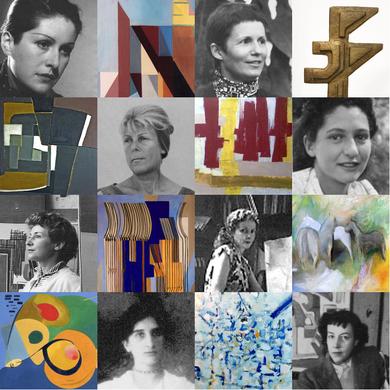In light of recent exhibitions at the Tate of Sonia Delaunay and Barbara Hepworth, both of whom were members of the Abstraction Création group in Paris, this exhibition at Hanina Fine Arts explores further into the relatively few women artists that achieved prominence in post-war Paris.
“The Second Sex” (Le Deuxième Sexe) was the title of Simone de Beauvoir’s influential and controversial 1949 book railing against the historical diminution of women, which promptly made it onto the Vatican’s list of prohibited books. The post-war years were a time of radical change in society, women were finally given the vote in 1945, as legislation creaked towards equality. It was only in 2005 that a woman artist represented France at the Venice Biennale for the first time in its 120 year history.
In 1897 women began to be accepted into the École des Beaux Arts in Paris, and in 1938 the first state exhibition of women artists, “Les Femmes Artistes d'Europe”, was held at the Musée Jeu de Paume. Valentine Prax was one of the artists who participated in that exhibition, and is represented in the HFA show by her surreal idiosyncratic painting “La Paysan au bord de la Mer”.
Today few women artists from the period are widely remembered besides Maria Helena Vieira da Silva and Germaine Richier. Many others, such as Nina Negri, who was part of Stanley William Hayter’s avant-garde “Atelier 17”, and whose name appears boldly on the 1936 “Manifeste Dimensioniste” alongside Kandinsky, Duchamp and Delaunay, have become relegated to the museum research libraries rather than blockbuster shows. HFA is showing two bold semi-abstract paintings by Negri from the 1950’s, “Composition d’Oro” and “Oscillation”.
Marcelle Cahn, subject of a retrospective at the Georgia Museum of Art in the U.S. last year, was at the forefront of the avant-garde through the early 20th century, a member of “Der Sturm”, “Société Anonyme”, “Cercle et Carré” and “Abstraction Création”, and was the only woman in the legendary 1925 show “Art d’Aujourd’hui”, which included Picasso, Leger, Gris et al. HFA’s exhibition includes an exquisite painting from 1949 that was exhibited at the Salon des Réalités Nouvelles.
Dora Maar’s life was overshadowed by her relationship with Pablo Picasso but she was a remarkable artist in her own right, a brilliant intellectual and Surrealist photographer. Once she had escaped the influence of Picasso she developed a powerful abstract style of her own, culminating in her Geometric compositions, although she declined to submit them to public scrutiny and they remained unseen until discovered in her apartment after her death in 1997. Two major works from this series are in the HFA exhibition.
One artist in the exhibition, Jacqueline Pavlowsky, whose work is a powerful and significant expression of post-war existentialism, resorted to signing her work “Vladimir”, which speaks a thousand words on the difficulties women were still confronted with.
The exhibition also includes a large gestural blue abstract work “Montagne,1961” by Marie Raymond who was a prominent member of the Abstraction Lyrique group, (the European equivalent of Abstract Expressionism in America), and exhibited regularly with Poliakoff, Soulages and Vieira da Silva.
Other artists in HFA’s exhibition include: Huguette Arthur Bertrand, Christine Boumeester, Patricia Diska, Boyadjieva Liuba, Maria Manton and Marevna.
For these women artists who did succeed in achieving renown, through unrelenting commitment and self-belief, we should be all the more respectful, and not allow them to become historical footnotes.
"absolutely intriguing" - Galleries Magazine
* The "Press Release" link below includes an extensive list of women artists working in Post-War France along with biographical summaries.

